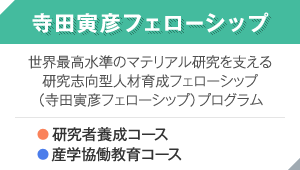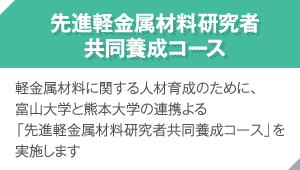- HOME
- 2025年度開講科目一覧 List of Classes 2025
- 大学院教養教育科目
講義概要
大学院教養教育科目
(科学技術と社会)MOT概論・基礎編
・学ぶ技術・考える技術
・ロジカルシンキング&超ロジカルシンキング
・グローバル競争の現状を知る(要約版)
・イノベーションとマーケティング
・経営戦略論入門
・イノベーションの方法論
・ワークショップ~クリエイティブに考える第1歩~
(科学技術と社会)デザインマネジメント
人間中心のイノベーションが求められています。これまでの経営手法である技術やマーケティングにデザインを加えることでユーザーの価値を探る多様な視点を得ることができます。左脳型か右脳型かということではなく、そのどちらも大切なのです。デザインマネジメントは既に、多くの欧米企業で実践され大きな成果を上げています。デザインマネジメントの概要紹介、クリエイティブディレクターの立場からみたデザインマネジメント、経営から読み解くデザインマネジメントで構成します。
(国際理解)Kumamoto-Mansfield Lecture Series
US-Japan Cooperation: Examining Nuclear and Security Issues
Course Description:
This course will provide an overview of US-Japan nuclear alliance issues and examine the history, current state and future of nuclear deterrence strategy. Topics ranging from the role of nuclear weapons in US-Japan security policies, energy cooperation, and efforts to eliminate nuclear weapons worldwide will be explored.
The US was the first country to obtain nuclear weapons and since then the modern military defense strategy has been closely intertwined with nuclear deterrence. In addition to US-Japan nuclear issues, the course will introduce the history of US nuclear deterrence, focusing on the military side of US build-up, reduction and future plans. Given the heightened tensions on the Korean peninsula in today’s climate, the prospects for progress on nuclear disarmament in the Trump administration will be discussed as well.
(国際理解)International Cooperation for Sustainable Development Goals
Objective of Course:
Each participant acquires an image of his/her activities for the achievement of Sustainable Development Goals (SDGs) in his/her country/region.
General Description:
This course covers various activities of Japan International Cooperation Agency (JICA) and other international organizations mainly in the field of higher education. Discussions will be made from the view point of SDGs. Not only students who are supported by JICA programs, but also those who are interested in activities in the higher education sector are most welcome to join the discussion.
(数理科学)歴史に学ぶ数学
ユークリッド幾何学成立から非ユークリッド幾何学の発見に到る歴史に特に注目しながら、古代から19 世紀までの数学史を(a)技術および方法論(b)思想的特性(c)担い手の社会的階層(d)社会的背景の変遷といった観点から概観する。多くの問題例や一次資料の検討を通して、各時代・地域における数学のあり方を鳥瞰し、数学史の技術史・思想史としての理解を目指す。同時に、現代数学における様々なものの見方や数学的技術などの立脚点や数学的意義についても目を向けることで、現代数学に対する一定の視角を得ることも目指したい。
- 1) 古代文明の数学
- 「定理」はどのような形でいつ頃から見出されたのか。特に「三平方の定理」および「ピタゴラスの三つ組」について、その古代の文献の検討および現代的な視覚・方法論からの数学的解説。
- 2) ギリシャの数学
- 「証明」はどのようにして生まれたのか。特に「原論」第I巻の概観。
- 3) アラビアから近代西洋
- 「数式」による数学の方法論はどのようにして可能となったのか。フワリズミー『ジャブルとムカーバラの書』の検討、ヴィエトの方法から微積分の発見。数学の担い手階級の広がりと変容、およびそれに伴う方法論的・思想的変化。
- 4) 平行線公準の歴史
- 平行線公準〈証明〉への試みの解説。
サッキエーリ四辺形、ランベルト四辺形。ランベルトの定理(ガウス・ボンネの定理)。 - 5) 非ユークリッド幾何学の
発見 - ロバチェフスキーおよびボヤイによる〈発見〉。ベルトラミ、ポアンカレなどによるモデルの構築。ポアンカレ円盤モデルの解説。リーマンによる基本的数学対象(=多様体)の発想から集合論への発展。これらをはじめとした19世紀数学における「存在論的革命」が内包する歴史的・社会的・思想的意味。
(数理科学)数学再論
数学は自然科学の基礎であり,数学における概念・思考方法・手法は汎用性が高い。理工系では学部の基礎教育において数学を学ぶが,汎用性の高い形で教授されるため,個々の内容がどの場面でどのように使われるか,ということについてはイメージがなかなかつかめないであろう。一方大学院において研究に着手すると,いろいろな場面で数学の思考や手法が使われていることに気付くであろう。そのような視点を持って数学をもう一度見直すことは,個々の研究にとっても有用なことと思われる。
この講義では,受講者がそれぞれの研究においてどのような形で数学を用いているか,ということを調べ,その経験を入り口として数学の理論を見直す。題材は受講者の研究内容に応じて適宜選択するが,微分方程式・線形代数・フーリエ解析・抽象代数学などを想定している。
(総合)産業特論
今、世界では新しい価値を創出する人材が求められており、それに応えうる存在として高度研究人材への注目が集まっています。また、グローバル競争においてリーダーシップを発揮できる人材としても、高度研究人材への注目が高まっています。このような現状を背景として、各産業界が高度研究人材に対して求めている役割や具備すべき素養、知識、スキル等を把握することが重要です。本講義では、「製造業のグローバル競争の現状を知る」に続いて、多様な業界を把握してもらうために、電機、鉄鋼及び複合材料、土木・建築、化学製品、医薬品、開発型地元中小企業、で構成します。
(総合)女性活躍社会を生きるということ ― 男性も女性も ―
- 男女共同参画の現状
- (1) 日本のGGGI(Global Gender Gap Index)
111位 (144か国中)が意味するもの - (2) 高等教育における問題
- (3) 政治における問題
- (4) 経済における問題
①賃金の男女格差
②職階の男女格差
③正規・非正規労働の推移問題 - (5) 健康における問題
- (6) 日本の少子化
- (7) 女性に対する暴力
- (8) 貧困は女性の顔を持つ
- (1) 日本のGGGI(Global Gender Gap Index)
- 男女共同参画行政の歴史
- (1) 国連から始まった
- (2) 日本国内の男女共同参画行政の進展
- (3) 女子差別撤廃条約
- (4) 男女共同参画社会基本法の制定(平成11年)
- (5) 男女共同参画基本計画
- (6) 地方自治体の動き
- (7) 女性活躍推進法の制定(平成28年)
- ポジティブ・アクションの意義と注意点
- ワーク・ライフ・バランス
- (1) 男性の家事育児
- (2) 長時間労働
- 最近の男女共同参画施策
- 最近の国連の動き
- (1) 女性エンパワーメント原則WEPs
(Women Empowerment Principles) - (2) 持続可能な開発目標(SDGs)
- (3) HeforShe
- (4) 2030年までにすべての分野でジェンダー平等達成目標(203050)
- (1) 女性エンパワーメント原則WEPs
(外国語リテラシー特別教育プログラム)科学英語演習Ⅰ
Describing Data, Complex Concepts, and Tips for Science Presentations
This course will focus on providing students with the opportunity to develop and practice skills that are useful for science presentations and also for the communication of complex ideas in general. There will be a section based around the fundamentals of describing charts and graphs which aims to provide learners with the skills that are necessary to accurately communicate key data during presentations. This section will form the backbone of the final assessment. In addition, there will be a section focused on practice communicating complex concepts, which draws on a range of scientific riddles/puzzles to provide students with a fun but challenging environment to practice communication. Finally, the course will aim to provide students with some skills for conference attendance, such as presentation tips, networking language, and how to ask and answer questions. Finally, through the use of a synthetic learning environment, there will be a fully communicative task-based activity on one of the days, based around the commercial video game Keep Talking and Nobody Explodes. The core goal of this course is to promote language development in a fun and engaging yet challenging way.
(外国語リテラシー特別教育プログラム)科学英語演習Ⅱ Advanced Academic Writing
This course is a series of workshop sessions aimed at improving your academic writing skills. Focus will primarily be on the fundamental elements of scientific composition and structuring a research paper fit for publication. Each session will introduce strategies on how to start and manage the writing process, plan each section of a paper, improve visual charts and data with clear legends, and edit for clarity and brevity. Participants will be given the opportunity to explore the topics covered through in-class exercises, group discussions, and individual activities. The course will conclude with a Q&A/feedback session and a graded written test to assess your comprehension and application of the topics covered.








